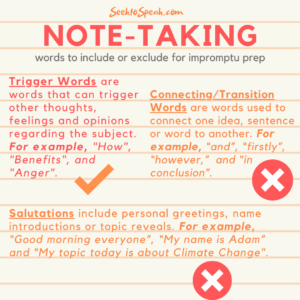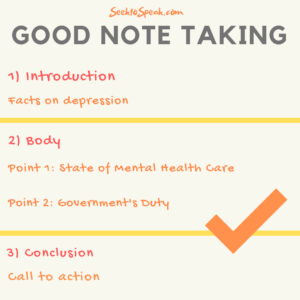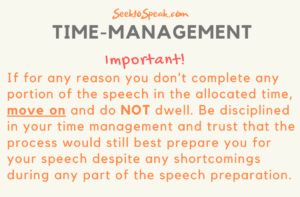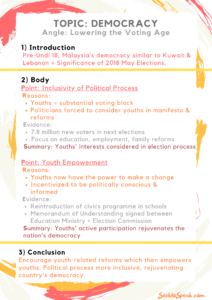Delivering an impromptu speech is very different from delivering a carefully prepared speech that is well-researched and well-rehearsed. Through my experience, students who would otherwise be vocal in class suddenly turn into meek mice the moment I give them a random topic to talk about. It is not because they were suddenly short of opinions or ideas. It’s just that the mere thought of having so little time to prepare sends their minds into a fritz.
I find that the root of all evil when it comes to delivering an impromptu speech is the nerves. It is the monster of anxiety that makes you think you don’t have enough of everything. Not enough time, not enough ideas, not enough practice.
Note-Taking & Time-Management
When tackling an impromptu speech, Note Taking and Time Management skills become exceptionally important. In the first installment of this series, we will look at how best to take your notes and manage your time, with what little moments you have to spare for your speech.
Always remember that these are neither novel or shocking tips, but rather, they are a collection of best practices. Things that are often forgotten or overlooked when preparing for an impromptu speech. This article also assumes that you have some time to prepare, rather than no time at all.
ReWriting, ReWording
The Problem
Under time constraints, people typically write down every single word of every single thought that they have for their impromptu speeches. I have seen students deliver disappointingly short speeches because all of their time and energy went into writing the speech in full, including obvious greetings like, “Good evening everyone!”, or name introductions like, “My name is…” Some students falter during delivery because they forgot where they were in their speech and can’t seem to pinpoint the next point in their notes, words spinning before their eyes. Other students use their notes as a crutch, reading every word rigidly, including grammatical errors, struggling with illegible handwriting, refusing to look up and face the audience.
Therefore, a good habit of speech improvisation is to have good note-taking skills. Here are the Dos and Don’ts in Note-Taking.
1) Trigger Words & Connecting Words
Only use trigger words in your notes. Trigger Words are words that can trigger other thoughts, feelings, and opinions regarding the subject. Write your thoughts in point-form and trust your ability to explain the idea the way it is envisioned in your head. Do not waste your time writing down connecting or transition words as well as salutations. These are things that you are already well-aware of and do not need word prompts within your notes to remember.

2) Clear division, Clear handwriting
Divide your speech into clear delineated portions in your notes with headings for the Introduction, Body, and Conclusion. These divisions should be arranged in its intended order of speaking. This allows you to be in complete control of your speech as you know where you are, how much content you have left, and how to adapt accordingly.
Write clearly in big bold handwriting and on ONE piece of plain paper. You mustn’t struggle to read your handwriting or doubt what is written on the paper. This makes it easier for you to refer to your notes quickly to maintain eye contact. Having everything in one paper prevents having to flip pages, wondering how much content you have left. Using plain A4 papers also prevents a speaker from being distracted by the lines in a normal notepad.

3) Practice while Prepping
Speak as you write even though you may not write down everything you say. Verbalizing your points as you jot down notes is like practicing your speech. It gets you comfortable with the ideas you are about to present. Should you find it difficult to verbalize your thoughts when you are preparing, the idea may be worth revisiting or revising.
For example,
your notes on the topic of “Teaching Science and Maths in English” should look like this*:
*The words in pink (Introduction, Body & Conclusion) should already be pre-written before the start of prep-time
Trouble with Timing? Prepare for Prep-time!
Now that you’ve got your notes down pat, we will look at how best to utilize what little time you have to prepare. This is about implementing an efficient time management system that should be strictly adhered to when preparing to deliver your impromptu speech. Therefore, always ensure that you are fully aware of how much time you have left during prep-time.
In this regard, I suggest allocating fixed amounts of time in completing different portions of your speech in the following order:
1) Angle and Strategy (20% of prep-time)
THE FIRST 20% of your allocated time should be utilized to decide on your approach to the topic and the strategy in which you wish to arrange your ideas. What stance do you want to take? Is it an informative or persuasive speech? What is current and trending? This is where you should already know the main headings and labels of your points.
2) Main Ideas (40% of prep-time)
THE NEXT 40% of your time should be spent in developing your main points following your chosen strategy providing the analysis or examples in support of your views.
3) Introduction & Conclusion** (20% of prep-time)
THE LAST 40% of your time should be on really getting your opening and closing perfect. This is where you would have finished the bulk of your speech and would know the best way to canvas your points and emphasize your message. This is also when you would clean-up your speech and review your notes.

For example…
I have 5 minutes to prepare a speech on the topic, Democracy.
In 1 minute, I should have decided how I would like to approach the topic. Since the May elections in Malaysia in 2018 made such a huge impact in the country and the topic of lowering the voting age is relatively current, my strategy would be to talk about the impact of lowering the voting age to Malaysian democracy. The inclusive nature of the policy and increased likelihood of political awareness comes to mind.
In the next 2 minutes, I start building on my first idea of how opening up the voting process to youths would change the political agenda by forcing politicians to take into account important issues that impact the youth, like education, employment, and family. Then I build on my second idea of increasing political awareness through the empowerment of youths. This can be done through civics lessons in schools and voter education. I will give the example of the Education Ministry’s memorandum of understanding with the Election Commission.
In the next 2 minutes, I will work on my introduction, choosing to point out that Malaysia is one of the very few countries, with the likes of Lebanon & Kuwait, that still retains such a high minimum voting age. I will talk about May’s elections and how important the democratic election process is. Then I will work to summarise my point and point out how ultimately, everything we do now is for our future children or children’s future and pose a question, “Why not then let the youths decide their future?”
At the end of 5 minutes, and using the PRES Template in the 2nd Instalment of this series (coming soon) and the Note-taking tips above, my impromptu speech notes will look like this:

(Bolded words should already be pre-written before the start of prep-time)
Please see here to learn how to build arguments and develop Logical Appeal.
Conclusion
Therefore, a lot of what goes into preparing for an impromptu speech is about maximizing the tools in your toolbox. It forces your mind to think quickly and to speak promptly. It makes you more aware of your speech, your notes, and your thoughts. Running impromptu simulations shapes good speaking habits and allows you to develop useful skills like critical-thinking and problem-solving.
In the next installment of this series, we will look at how to template think and speak. It is the best way to get your ideas through within the shortest amount of time.
Extra Tips!
**PS. Hello & Goodbye
Much like how a plane is most likely to crash when take-off or landing, you are most likely to be nervous at the beginning of the speech – when you’re most aware of the audience – and at the end of your speech – when you run out of things to say.
Therefore, before you begin your impromptu speech, get your introduction and conclusion in order. These are the only two portions of your speech which you need to be especially confident about. A strong introduction will give you the assurance to deliver the rest of your speech well and creates a positive first impression on the audience that would carry you later if you falter. Pre-planning your conclusion would take away the worry of not having anything else to say and ending your speech abruptly. It allows you to summarise your thoughts, lengthening the time of your speech and solidifying your message, making you more effective as a speaker.
Pacing while Delivering
Is it also very important to be aware of your time WHILE delivering the impromptu speech. If you are only in the first portion of your notes, i.e. the Introduction, and you only have 40% of speech time left, you are going much too slow. If you are in the last portion of your notes, i.e. your Conclusion, within the first 40% of your speech time, then you are going much too fast.
Organizing your notes using the note-taking methods above also allows you to have a quick bird’s eye view of your speech and to manage your time accordingly. This is where you will start changing the pace of your speech in accordance with how fast or slow you are speaking following how much or how little left you have to say. As a general rule, I would give between 30seconds to 1minute each for the introduction and conclusion, but nothing above 1minute and 30seconds, regardless of how long the speech or how great its content.
Try this!
This is an easy exercise to show the efficacy of Trigger Words and how much can be done with fewer words. Pick a random topic and write down the first 3 words that come to your mind. After writing down the words, try explaining to yourself why those words were chosen and the type of ideas you would have talked about. You’d find that it is quite an easy exercise to do and you would not be short of words to justify your choice.


